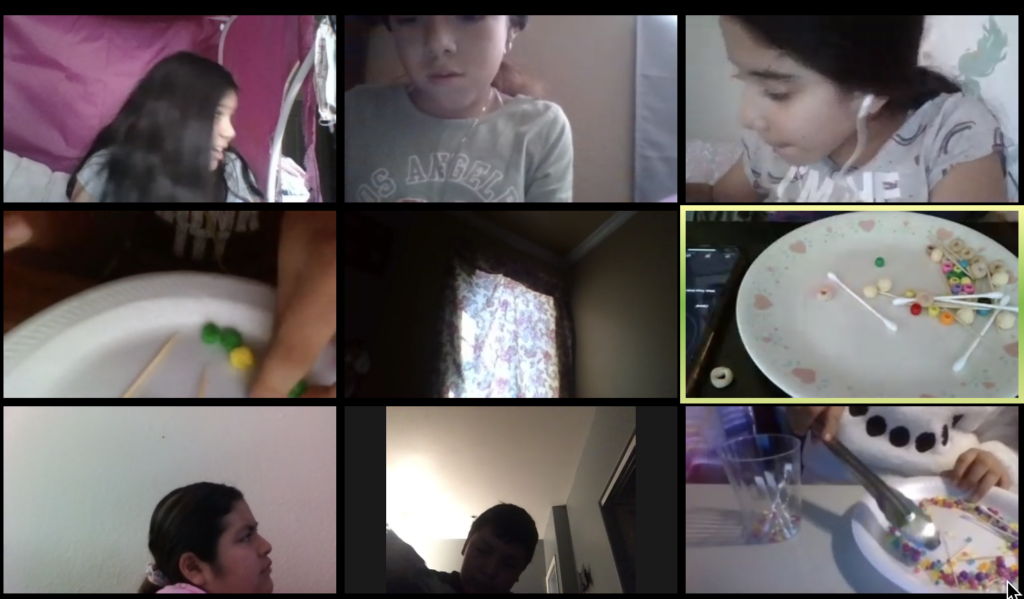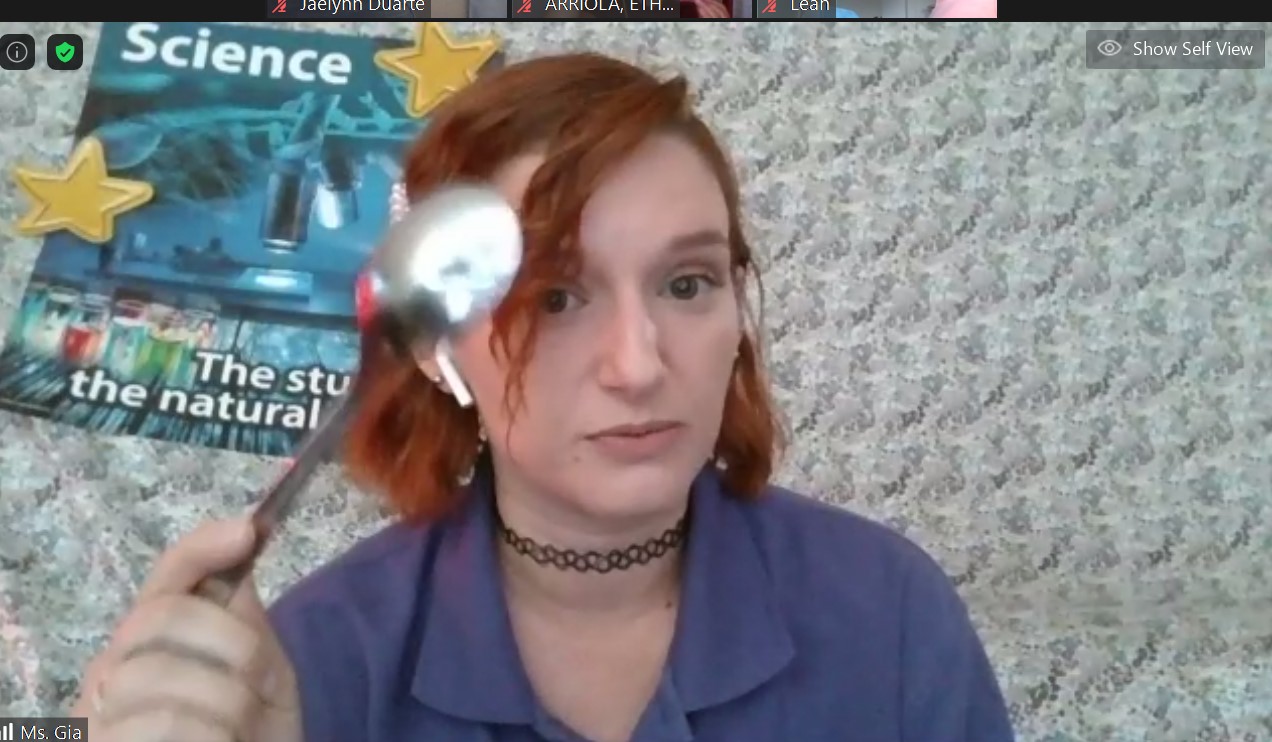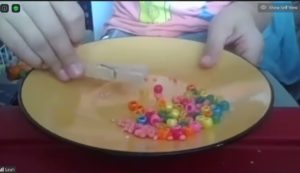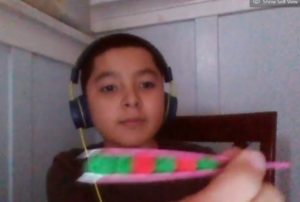With classrooms closed, scientists take over virtual STEM lessons in LA Unified

Sixth-grade students in L.A. Unified show off their findings via Zoom after a easily-on science lesson led by an instructor at the Discovery Cube children's museum.

Sixth-grade students in L.A. Unified show off their findings via Zoom after a hands-on science lesson led by an instructor at the Discovery Cube children's museum.
Field trips and hands-on lessons are an integral part of 1000-12 scientific discipline teaching — at to the lowest degree they should exist in normal times. But they have virtually disappeared this school yr as a upshot of students learning from home.
Now, as California is experiencing another coronavirus surge and distance learning continues for by far the bulk of students, scientists and museum guides are trying to make full the gap and are taking to Zoom to come across students at home.
Teachers have come up up with creative solutions to get students to log on and appoint in scientific thinking and experimentation this schoolhouse year, when the bulk of students in California are taking at to the lowest degree part of their classes remotely and don't accept admission to the lab equipment or other science supplies typically available on school campuses.
And while a few districts, such as Plumas Unified in Northern California, have embraced outdoor education as i alternative to online learning, wildfires and recent surges in coronavirus cases and hospitalizations have hindered those efforts.
One successful strategy that a handful of school districts are taking has been to pull in outside experts to teach topics ranging from aeronautical engineering to agricultural science. Sometimes private teachers volition invite experts to almost visit their students, while other districts similar Oakland Unified are taking broader approaches to help coordinate visits for teachers who express interest.
In Los Angeles Unified, California's largest school district, district officials launched a pilot projection this summer that brought educators from science museums throughout Southern California to offer students virtual afterwards-school enrichment activities in science, technology, engineering and mathematics, or Stalk.
Equally it became clear that schools in Los Angeles would non return for in-person instruction in the fall, commune leaders decided to fold the plan into the normal school day.
Now, through a programme dubbed the "Season of Stalk," every 5th-grader in L.A. Unified's Local Commune Key — almost 8,000 students — receives a virtual visit on Midweek from local scientists who talk them through a lesson and an activity using simple materials at habitation. L.A. Unified is divided into vi local districts, and Local Commune Central covers communities spanning from Downtown Los Angeles to Eagle Rock.
The plan includes 26 different STEM organizations who take turns leading a one-hour lesson every Wednesday for virtually 230 5th-grade classes. On Fridays, teachers go deeper on that week's topic with their students. And after three weeks, a different arrangement comes in and the bicycle repeats.
"It's difficult to know what materials students have at home when planning lessons and experiments," said Jessica Polo, a 5th-grade teacher at Trinity Street Elementary in Los Angeles who has been hosting Flavor of Stem lessons. For her, the guest speakers have been a welcome relief during an already stressful year for lesson planning.
"They are very knowledgeable in these specific fields," Polo said. "I don't know if I would have the same knowledge virtually all of these topics."
On a recent Wednesday, 2 educators from the Discovery Cube, a children's science museum located north of Burbank, led a word virtually bird adaptations and evolution with Polo's students, who were all at home learning remotely. After providing students with some vocabulary and discussing why dissimilar bird species accept different features, the Discovery Cube instructors led students in a easily-on activeness to test different beak shapes at dwelling house.

An educator from the Discovery Cube walks students through an activity with household objects.
"What special adaptations or characteristics are dissimilar?" Discovery Cube instructor Devon Ohlwiler asked students as they were shown images of different bird species. Students chimed in with responses, and Ohlwiler and so challenged students to think of why those differences might exist. Students shared guesses, eventually coming to a determination led by Ohlwiler that each species has evolved differently to survive in its unique environs and eat specific foods.
To reinforce the idea, students gathered supplies such as spoons, chopsticks and clothespins to choice upwards other items like cereal, rice or board game pieces. And so they shared via Zoom how different shapes and surface areas on the tools might make information technology easier or harder to pick upwardly different objects, representing how bird beaks take adjusted to different diets.

Students at Trinity Street Uncomplicated school exercise picking up household objects with small tools to see what surfaces and sizes are about effective.

Fifth-grader Ethan Arriola shows how many beads he was able to pick up with tweezers representing a long pecker.
"I used a plier, and I tin can choice up two items at a time," Ethan Arriola, who attends Trinity Street Simple, shared with the grade. "And so a long beak tin shop more things while information technology hunts for more than food."
Other classes have given students a look at environments and scientific phenomena happening near where they live. Instructors from the LA Maritime Institute, Emerald Bay Outdoor Academy and the USC Bounding main Grant, a plan at the Academy of Southern California focused on oceans and the communities near them, for example, launched a travel serial for the Season of STEM where the instructors taught live virtual lessons from the outdoors. Lessons took place upwardly and down the Southern California coastline, from the San Pedro Bay in Long Beach to Santa Monica Bay further north.
Wrangling together partners and figuring out how to piece of work with the district'due south altitude learning schedule wasn't simple — or cheap. The Eli and Edythe Wide Foundation, a major proponent of STEM teaching in Los Angeles, contributed $350,000 to create the after-schoolhouse lessons this past summer and gave partner organizations a total of $i.one meg this fall for the Season of STEM program.
Similar many districts across the land, Los Angeles Unified has struggled to navigate distance learning when some students exercise not have steady admission to the cyberspace at habitation, need to share a computer, or their parents work and can't be effectually to assist with schoolwork during the day.
Despite all the challenges with virtual learning, online classrooms take created an unexpected opportunity for experts to connect with students in ways they might non be able to in a traditional school year, said Ben Dickow, president of the Columbia Memorial Space Center, a hands-on infinite museum in the city of Downey, which is providing Stalk lessons through the programme.
"If this wasn't during Covid time, and we brought this idea in, we'd have to be more than classroom-oriented," Dickow said. But with virtual learning, students can do standards-based science at home, in their backyard, or get a glimpse at scientists in their field themselves. "Y'all can do standards-based science just you don't have to be in the classroom," he said.
His organization and others involved with the Season of STEM teamed upward last year with Los Angeles Mayor Eric Garcetti to expand Stalk teaching efforts beyond the urban center. The intention was to offer science learning experiences for students for enrichment, such as afterwards-school programs, but grew into a class-time activeness for distance learning subsequently success in the summer.
"It'southward not a secret that there is a general deficit with Stalk instruction, especially in elementary schools considering teachers often aren't trained in that," said Dickow, referring to how elementary teachers often have a full general teaching education credential rather than a designated subject field credential in math or science.
Recently, Polo, the instructor at Trinity Street Elementary, has started tying the science lessons to other subjects like social studies and English language language arts, similar a contempo series about copse and agriculture from the environmental nonprofit TreePeople.
"In social studies, my students are finishing upward a project about Native Americans and farming and information technology actually ties into our science lessons," said Polo, who recently gave her students seeds and planters to do growing plants from abode that they show her on Zoom. "It'south reinforcing what I'm teaching."
Dickow, of the Columbia Memorial Science Centre, jokes that "everybody is edifice the plane in the air right now." But he and other program participants are hopeful that the new partnerships volition suffer beyond the pandemic when students are back in school.
"We accept gotten great feedback from teachers, and it's been super heartening to encounter the local Stalk customs come up together. And it's non only a response to Covid," he said. "We want to go on this work together in the future."
To go more reports like this one, click here to sign upwardly for EdSource'southward no-cost daily email on latest developments in didactics.
blackwoodfelf1976.blogspot.com
Source: https://edsource.org/2020/with-classrooms-closed-scientists-take-over-virtual-stem-lessons-in-la-unified/644253
0 Response to "With classrooms closed, scientists take over virtual STEM lessons in LA Unified"
Post a Comment